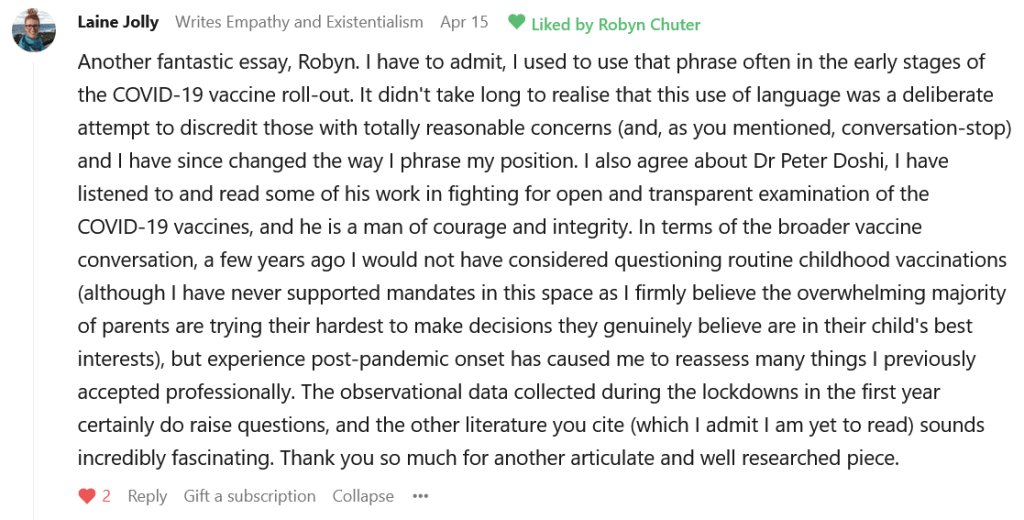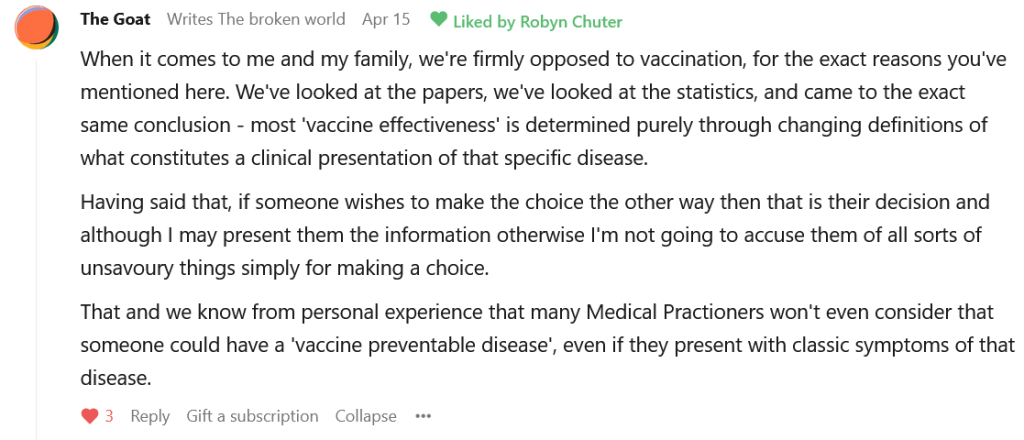Backlash: How the vaccine pushers turned true believers into vaccine sceptics - Part 1
The World Health Organisation places "vaccine hesitancy" in the top 10 threats to global health, but its own behaviour does not inspire public confidence in vaccines.
There’s a fascinating phenomenon that I’ve been observing in the Comments section of my Substack. As I mentioned in a previous post, Are doctors the new antivaxxers?, people who have never before questioned the safety or efficacy of vaccines, or the role they have played in reducing sickness and death from infectious disease, are now casting a critical eye over the entire vaccine enterprise.
This new-found vaccine scepticism covers the gamut from wondering whether particular vaccines are safe, effective or necessary, to questioning the childhood vaccination schedule, to outright rejection of anything that carries the label ‘vaccine’.
Here is a sampling of typical comments:
I’m not the only who has noticed that more and more people who previously unquestioningly accepted pretty much any vaccine they were offered, both for themselves and their children, are now expressing curiosity, doubt, and even outright hostility to vaccines, and the public health apparatus that advocates for them – and increasingly, mandates them for participation in activities integral to everyday life.
In an article titled ‘The Vaccine-Hesitant Moment‘, published on 7 July 2022 in The New England Journal of Medicine, Heidi Larson and co-authors described, with evident alarm, the coalescence of a few small, scattered stones of vaccine scepticism into a global landslide of so-called “vaccine hesitancy”, in the context of the rushed development of the experimental COVID-19 injections.
Regular readers might remember Heidi Larson from Are doctors the new antivaxxers? Just weeks before the first case of COVID-19 was identified in Wuhan, China, Larson warned “vaccine safety stakeholders” at the World Health Organisation’s Global Vaccine Safety Summit (held 2-3 December 2019) that research conducted by the Vaccine Confidence Project had identified worrying signs of declining confidence in vaccines among health care professionals. (Like that other notorious gabfest, Event 201, the remarkably prescient timing of the WHO summit can of course be entirely explained by the models formulated by the rapidly-developing branch of science known as coincidence theory.)
Larson, an anthropologist by training, has no academic credentials in immunology, vaccinology, virology, evidence-based medicine or health econometrics. Fortunately for her, none of these were prerequisites for becoming the director of the Vaccine Confidence Project, which is a designated “WHO Centre of Excellence on addressing Vaccine Hesitancy” backed by pharmaceutical companies, the secretive globalist think-tank Chatham House (of which Larson is a Global Health Security Fellow), and a gaggle of not-for-profits and NGOs with deep ties to Big Pharma. (The interest of these corporations and conflict-of-interest-ridden organisations in promoting public confidence in vaccines can of course be entirely explained by their unbridled love of humanity which, according to coincidence theorists, overrides motives such as the desire for financial profit and the total control of human activity facilitated by the implementation of a biosecurity state.)
Previously, Larson chaired the Advocacy Task Force of the Bill Gates-founded Gavi, the Global Vaccine Alliance whose stated aim is to “improve the health of markets for vaccines and other immunisation products”. (Gates’ US$750 million investment in Gavi can also be entirely explained by his unbridled love of humanity and has absolutely nothing to do with his demonstrated commitment to monopolistic domination of every market he enters.)
Finally, Larson is proudly featured by the World Economic Forum as an “agenda author”. (The interest of the WEF in Larson’s work has absolutely nothing to do with the family ties of founder, Klaus Schwab and sponsor, Prince Bernhard of the Netherlands, with the Nazi regime, and everything to do with their concern that humanity achieve its full potential for happiness [by owning nothing and having no privacy] through the vehicle of public-private partnerships – just like that formed between the Nazis and infamous chemical and pharmaceutical manufacturer IG Farben, for whom Bernhard worked before he married into the Dutch royal family.)
But I digress. Let’s get back that NEJM article, ‘The Vaccine-Hesitant Moment’. Noting that WHO has designated vaccine hesitancy as “one of the top 10 threats to global health”, Larson and her coauthors blame a number of factors for the recent explosive growth in this existential threat to humanity, including:
The use of the Internet by people to “search online for health information”, “in a landscape of confusing misinformation and disinformation alongside accurate, scientifically based information”.
The capacity of the Internet, and especially social media platforms, to propagate “anti-vaccine” messaging, by “offer[ing] a new opportunity for people with shared beliefs to self-organize across geographic regions, influencing and sometimes disrupting public confidence and cooperation”;
“A wider decline in trust of expertise and authority”;
“Different modes of belief-based extremism” (aka adherence to “conspiracy theories”);
“Political polarization”;
“Libertarian views”; and
“Alternative health care advocacy”.
Collectively, according to Larson et al, these factors “trigger… public questioning about the importance, safety, and effectiveness of vaccines.”
If you’re starting to bristle just a little at the unstated attitude lurking beneath this cataloguing of the various forms of wrongthink underlying vaccine hesitancy – that is, that if you’re not 100% on board with taking every vaccine recommended by the public health-industrial complex, you must be a stupid, selfish and antisocial rube who has no right and no business using the Internet to research topics or meet and organise with like-minded peers, let alone to question the “experts” and “authorities”, hold unsanctioned political views, or choose non-state-sanctioned health care paradigms – congratulations: you’ve managed to retain at least a modicum of self-respect, as well as some capacity for critical thinking.
Critical thinking, however, is not one of Larson and her co-authors’ strengths. Their highly selective recounting of the 2009 H1N1 flu debacle, for example, provides a lesson in the dual arts of memory holing and doublethink that would set Orwell back on his heels.
Whilst admitting that “the initially feared 2009 H1N1 pandemic was not as severe as anticipated” and that “by the time the H1N1 vaccines were available, few people wanted them, and some were angered at the perceived hyping of the pandemic risk”, they are clearly sympathetic to the bemusement experienced by “public health experts”, who “convened to reflect on why there was such low uptake of the influenza A (H1N1) vaccine, which was hurriedly developed in response to the pandemic alert issued by the World Health Organization (WHO).”
That July 2010 meeting spawned a report, titled ‘A Crisis of Public Confidence in Vaccines’ which “heralded a warning: ‘The lack of public confidence in vaccines risks undermining the political will necessary to rapidly respond to a more severe influenza pandemic in the future.’”
Moreover, when it comes to castigating the public for failing to roll up their sleeves for the H1N1 vaccine, this is not Larson’s first rodeo. Writing in the Financial Times in February 2018, Larson complained that
“In 2009, during the swine flu pandemic of the H1N1 influenza virus, poor public co-operation and low acceptance of the vaccine was a wake-up call. The public might fall for faulty science, but the more worrying trend in 2009 was the lack of civic responsibility and co-operation.”
What Larson and her coauthors conveniently fail to mention is that in January 2010, the Parliamentary Assembly of the Council of Europe had launched an investigation of the “‘falsified pandemic’ that was declared by WHO in June 2009 on the advice of its group of academic experts, SAGE, many of whose members have been documented to have intense financial ties to the same pharmaceutical giants such as GlaxoSmithKline, Roche, Novartis, who benefit from the production of drugs and untested H1N1 vaccines.”
The resolution authorising the investigation noted that
“In order to promote their patented drugs and vaccines against flu, pharmaceutical companies influenced scientists and official agencies, responsible for public health standards to alarm governments worldwide and make them squander tight health resources for inefficient vaccine strategies and needlessly expose millions of healthy people to the risk of an unknown amount of side-effects of insufficiently tested vaccines.”
Even that noted purveyor of tinfoil hat conspiracy theories, Forbes Magazine, fumed that “the World Health Organization’s actions have ranged from the dubious to the flagrantly incompetent,” taking it to task for declaring H1N1 a “pandemic” on the basis of its spread rather than its virulence.
The Council of Europe report on the fake pandemic went even further, castigating WHO for changing the definition of a pandemic (by dropping the virulence criteria) in May 2009, just one month before they declared that H1N1 had crossed the pandemic threshold, and then denying that they had done so:
“WHO continues to assert that the basic definition of a pandemic was never changed. Only the description of pandemic alert levels was revised when the document ‘Pandemic influenza preparedness and response: A WHO guidance document’ (new title) was updated in May 2009. Notwithstanding these assertions, there is clear evidence that changes were made and that, most importantly, the former criteria of ‘impact and severity’ of an epidemic in terms of the number of infections and deaths was no longer considered relevant in the updated document.
In other words, the pandemic could be declared without the need to show that it was likely to be severe in terms of its impact on the population (for example, regarding severity of illness and death). The definition before 4 May 2009 was worded as follows: ‘An influenza pandemic occurs when a new influenza virus appears against which the human population has no immunity, resulting in epidemics worldwide with enormous numbers of deaths and illness. With the increase in global transport, as well as urbanization and overcrowded conditions, epidemics due to the new influenza virus are likely to quickly take hold around the world’, whilst the same definition became the following on WHO’s website after this date: ‘A disease epidemic occurs when there are more cases of that disease than normal. A pandemic is a worldwide epidemic of a disease. An influenza pandemic may occur when a new influenza virus appears against which the human population has no immunity …. Pandemics can be either mild or severe in the illness and death they cause, and the severity of a pandemic can change over the course of that pandemic'”.
It subsequently emerged that one of the vaccines that was only able to be rushed to market because of the WHO’s “falsified pandemic” declaration, Pandemrix, caused astonishingly high rates of serious disorders including narcolepsy, facial palsy, convulsions and death. Yet multiple governments continued to distribute and promote Pandemrix even after their own pharmacovigilance systems had detected a clear safety signal… and long after it had become evident that H1N1 was an unusually mild strain of flu.
In other words, it simply wasn’t the case that the public shied away from the H1N1 vaccines because they lacked a sense of civic duty or had “fallen for faulty science”. Instead, public health agencies both acted on and actively manufactured faulty science, and in so doing, abandoned their responsibility to act in the best interests of the populations they were meant to be stewarding.
But instead of acknowledging that the sordid tale of corruption of the WHO revealed by the Council of Europe’s investigation, and the slavish adherence to its absurd diktats by national health agencies, provides perfectly rational grounds for mistrust, Larson and co arrogantly interpret any questioning of vaccines as prima facie evidence that you’re merely an ignorant twat who’s spent way too much time listening to conspiracy theorists on the Internet instead of “experts” and “authorities”.
Determined not to acknowledge the presence of the pachyderm in the parlour, these highly-credentialled stupid people proceed to spend many paragraphs wringing their hands over the rapid spread of negative news stories (which, according to their Ministry of Truth criteria, always constitute “misinformation” even if they’re accurate) on social media, and gaslighting individuals who suffer adverse effects after vaccination or observe them in their children.
Remarkably, not even once in this tedious screed do they acknowledge the possibility that people might be more trusting of health authorities if those authorities didn’t have a proven track record of pandering to their vaccine manufacturer buddies whilst lying to the people they’re supposed to be serving, and callously dismissing their lived experiences of vaccine harms as the ravings of hysterical “antivaxxers” (which defies logic, since they had to accept vaccination in order to experience adverse events in relation to it).
Instead of urging public health authorities to tell people the truth, their proposed solution to the “crisis” of vaccine hesitancy is to carry out sophisticated monitoring of social media so they can equip vaccine providers to more effectively fob off patients’ perfectly valid concerns.
If you feel insulted by these academics’ utter contempt for your capacity to assess information and your right to make healthcare decisions that accord with your personal values, spare a thought for clinicians and researchers who attempt to conduct and publish research that questions, to even the slightest degree, the safety and efficacy of vaccines.
We’ll throw open the doors to that wing of the vaccine funhouse in Part 2.










Vaccine is all about trust. Trust in vaccines is like trusting your spouse. If you think your spouse is home cooking you dinner when in fact you discover she’s in a wild orgy with your two best friends, you’ll never trust her again, right? If you think someone is checking the safety and efficacy of the vaccines you are giving your children, but then you find out the people in charge of this programme are nothing but a bunch of greedy fat rats with complete disregard for human life and unbelievable conflicts of interests who would come to the point of allowing a literal toxin (spike protein) to be injected in babies, you kind of lose the trust in the whole thing.
Thanks for this. The Spiegel from Germany covered some of the issues around this fake pandemic in 2010 which you might find interesting. Hard to believe people might be skeptical when governments and public health officials act like this.
https://www.spiegel.de/international/world/reconstruction-of-a-mass-hysteria-the-swine-flu-panic-of-2009-a-682613.html
https://www.spiegel.de/international/germany/second-class-medicine-germans-unhappy-with-alternative-swine-flu-vaccine-for-politicians-a-656028.html